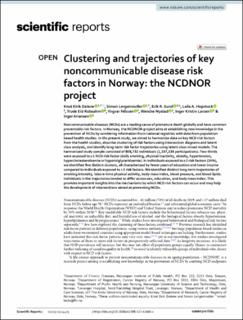Clustering and trajectories of key noncommunicable disease risk factors in Norway: the NCDNOR project
| dc.contributor.author | Dalene, Knut Eirik | |
| dc.contributor.author | Lergenmuller, Simon | |
| dc.contributor.author | Sund, Erik Reidar | |
| dc.contributor.author | Hopstock, Laila Arnesdatter | |
| dc.contributor.author | Robsahm, Trude Eid | |
| dc.contributor.author | Nilssen, Yngvar | |
| dc.contributor.author | Nystad, Wenche | |
| dc.contributor.author | Larsen, Inger Kristin | |
| dc.contributor.author | Ariansen, Inger | |
| dc.date.accessioned | 2023-11-09T06:43:51Z | |
| dc.date.available | 2023-11-09T06:43:51Z | |
| dc.date.created | 2023-09-15T12:12:35Z | |
| dc.date.issued | 2023 | |
| dc.identifier.citation | Scientific Reports. 2023, 13 (1), . | en_US |
| dc.identifier.issn | 2045-2322 | |
| dc.identifier.uri | https://hdl.handle.net/11250/3101527 | |
| dc.description.abstract | Noncommunicable diseases (NCDs) are a leading cause of premature death globally and have common preventable risk factors. In Norway, the NCDNOR-project aims at establishing new knowledge in the prevention of NCDs by combining information from national registries with data from population-based health studies. In the present study, we aimed to harmonize data on key NCD risk factors from the health studies, describe clustering of risk factors using intersection diagrams and latent class analysis, and identify long-term risk factor trajectories using latent class mixed models. The harmonized study sample consisted of 808,732 individuals (1,197,158 participations). Two-thirds were exposed to ≥ 1 NCD risk factor (daily smoking, physical inactivity, obesity, hypertension, hypercholesterolaemia or hypertriglyceridaemia). In individuals exposed to ≥ 2 risk factors (24%), we identified five distinct clusters, all characterized by fewer years of education and lower income compared to individuals exposed to < 2 risk factors. We identified distinct long-term trajectories of smoking intensity, leisure-time physical activity, body mass index, blood pressure, and blood lipids. Individuals in the trajectories tended to differ across sex, education, and body mass index. This provides important insights into the mechanisms by which NCD risk factors can occur and may help the development of interventions aimed at preventing NCDs. | en_US |
| dc.language.iso | eng | en_US |
| dc.publisher | Springer | en_US |
| dc.rights | Navngivelse 4.0 Internasjonal | * |
| dc.rights.uri | http://creativecommons.org/licenses/by/4.0/deed.no | * |
| dc.title | Clustering and trajectories of key noncommunicable disease risk factors in Norway: the NCDNOR project | en_US |
| dc.title.alternative | Clustering and trajectories of key noncommunicable disease risk factors in Norway: the NCDNOR project | en_US |
| dc.type | Peer reviewed | en_US |
| dc.type | Journal article | en_US |
| dc.description.version | publishedVersion | en_US |
| dc.source.pagenumber | 0 | en_US |
| dc.source.volume | 13 | en_US |
| dc.source.journal | Scientific Reports | en_US |
| dc.source.issue | 1 | en_US |
| dc.identifier.doi | 10.1038/s41598-023-41660-x | |
| dc.identifier.cristin | 2175461 | |
| cristin.ispublished | true | |
| cristin.fulltext | original | |
| cristin.qualitycode | 1 |

